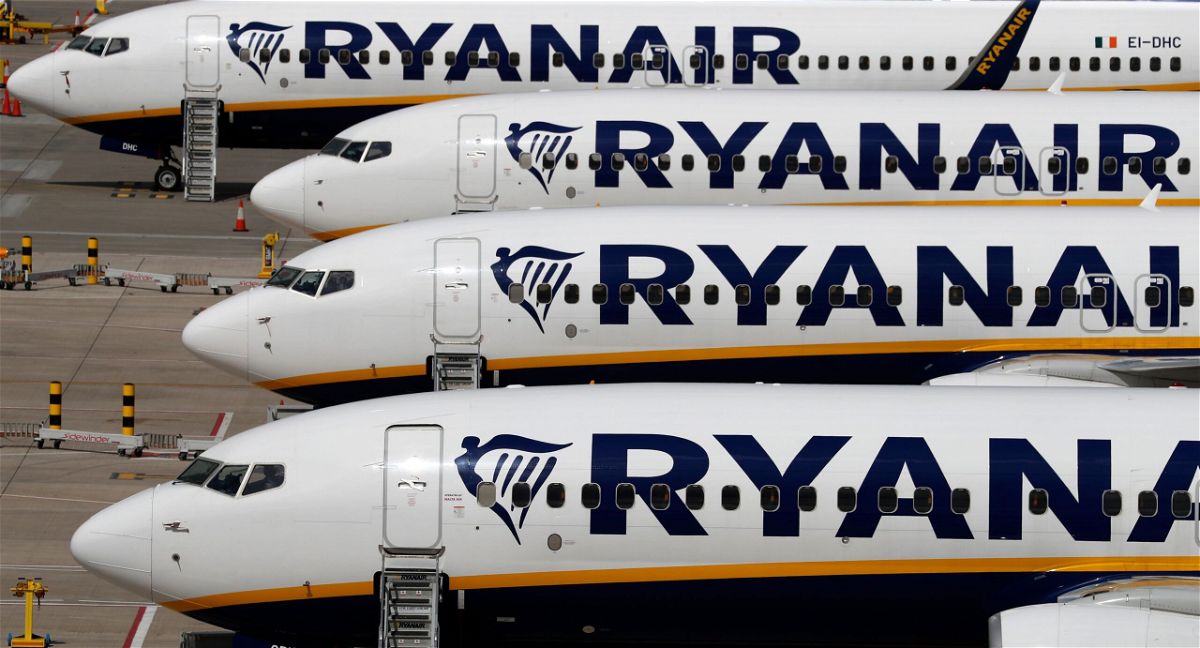Flight carbon calculators and offsets: How do they work and can we trust them?

Ryanair boss Michael O'Leary says most consumers aren't interested in paying extra for carbon offsetting.
By Paul Sillers, CNN
As we gratefully return to air travel post-Covid, it’s a good time to reflect on the choices we can personally make to reduce our environmental footprint.
However, it’s not always easy. While there are plenty of flight carbon calculators offered by airlines and comparison portals, the methodologies can seem opaque and results vary from site to site.
In a recent furore, Google was accused of “greenwashing” its Google Flights calculator, after an algorithm change resulted in flights appearing to have less environmental impact than before.
To understand how best to make use of these calculators when planning our trips, we first need to understand how they work.
While most of us are aware of air travel’s carbon dioxide emissions’ connection to global warming, not everyone knows that jet engines also spew out a cocktail of other noxious substances.
We’re talking nitrous oxide, unburned hydrocarbons, carbon monoxide, sulfur oxides, traces of the hydroxyl family, nitrogen compounds, water vapor and soot particles.
The environmental effects of aviation’s CO2 emissions are well documented, but the non-CO2 impacts are less well agreed upon by the scientific community — and it’s a challenge to measure them meaningfully.
The global industry standard is to measure carbon footprints in kgCO2e, or kilograms of carbon dioxide equivalent.
This figure is reached by multiplying the actual carbon dioxide measurement by 1.9 in order to reach a new estimate which reflects the combined impact of all jet emissions, not just CO2.
The idea is to provide consumers and corporations with a universal measurement for comparison.
Armed with this figure, emissions for flight routes can be calculated, taking into account variables like aircraft type, flying time, distance, seat capacity and occupancy (load factor), and the amount of freight carried.
“If you give people better data, they’ll make spending decisions linked to sustainability,” said Kit Brennan, founder of Thrust Carbon, a UK-based emissions intelligence platform.
“On the corporate side,” he added, “some companies are spending over a billion dollars annually on travel programs, and are telling their suppliers they’ll only go with airlines that have below-average emissions on transatlantic routes — that’s a really strong incentive for an airline to improve efficiency.”
The problem with the carbon equivalent formula, Brennan told CNN, is that while “the 1.9x multiplier used by the UK government is based on the most reliable research available, other research implies the multiplier could be as high as four times the emissions, so it’s a huge range.”
A new carbon equivalent calculator was announced in June by the International Air Transport Association, CO2 Connect, an online tool which it says provides the most accurate CO2 emission calculations for any given commercial passenger flight. However, this does not take account of the non-CO2 impacts and other industry experts agree that emissions figures need to be treated with caution.
A spokesperson for Finnish oil refiner Neste, a specialist in Sustainable Aviation Fuel (SAF), tells CNN that “The non-CO2 impact of aviation can be two-thirds of the total climate impact, but research on non-CO2 effects is still evolving.”
Airlines are similarly circumspect. EasyJet PR manager Andy Cockburn told CNN that some carbon calculation methodologies currently in use should be treated with caution. “One common industry practice, used in some carbon calculators, is to over-attribute fuel burn to belly freight cargo. This can make the CO2 per passenger appear up to 60% lower than it really is.”
As for the multiplier, he said that easyJet agrees with the principle that non-CO2 effects should be communicated to the consumer to help them make better-informed decisions. “However,” he added, “non-CO2 effects cannot yet be shown accurately on a per-flight basis, because most of the non-CO2 effects happen on a relatively small proportion of flights and are non-cumulative, whereas carbon is cumulative.”
The airline says it supports efforts to develop ways of showing non-CO2 accurately on a per-flight basis and intends to “update its views in line with the latest science.”
Where does this leave consumers?
So, leaving aside the multiplier debate and bearing in mind that a blunt tool is better than no tool at all, what will environmentally conscious travelers find when they check out the emissions data provided on the booking portals of airlines and flight comparison sites?
At the time of writing, the quoted carbon emissions generated for a non-stop one-way Paris (CDG) – New York (JFK) ticket is 478 kilos of CO2 per passenger, according to Air France’s carbon calculator.
But the same trip, by Google Flights’ reckoning, generates 394 kilos of CO2 if traveling with American Airlines; 356 kilos of CO2 if flying Delta; or with Air France the quoted emissions range between 292 kilos if the aircraft in use is an Airbus A350, or 416 kilos when flying with the carrier’s Boeing 777 aircraft.
Google says its calculations are derived using the European Environmental Agency (EEA) emission estimates, using “the most up-to-date algorithmic model.” Diligent emissions sleuths keen to plow through the 51 pages of technicalities can access the EEA guidebook here. It provides a breakdown of the emissions from different aircraft types — handy when trying to fathom which is the least polluting aircraft to choose on your next flight.
It’s also interesting to check out other carbon calculators for comparison. Virgin Atlantic’s carbon calculator, for example, states that a CDG-JFK direct flight produces 870 kilos of carbon emissions — noticeably higher than the other calculators. Or, head over to Terrapass, which states that the same flight generates 2,344 lbs (1,063 kilos) of CO2e (note that Terrapass’s calculator quotes the Carbon equivalent, not just the CO2).
But won’t offsets cancel out the emissions, anyway?
Consumers might well throw their hands up in the air and decide that, regardless of emissions quantity, carbon offsets are an option that will simply cancel out their flight’s environmental impact. Right?
The premise behind offsets is that by investing money in projects such as wind farms, clean cookstoves and so on, the negative effects from aviation emissions can, on balance, be neutralized. IATA is relying on offsets and carbon capture to deliver 19% of its FlyNetZero commitment for airlines to achieve net zero carbon by 2050.
But how keen are consumers to offset their flight’s emissions? According to the Civil Aviation Authority’s 2021 consumer research tracking study, 41% of respondents agree or strongly agree that they think about the impact of flying on the environment when considering traveling by air. Additionally, 39% agree or strongly agree that they would pay more for flight tickets to reduce the environmental and/or noise impact of flying.
But good intentions aren’t deeds. When airlines ask their customers to dip their hands in their pockets to offset their flight’s carbon emissions, the evidence tells a different story.
Speaking about voluntary offsets at the November 2021 Eurocontrol Aviation Sustainability Summit, Ryanair boss Michael O’Leary revealed that “the uptake last year was 1%.” He added that there’s a “big disconnect between passengers on a customer survey going ‘yes, we want carbon offsetting, we want to do this’ and then ask them will you voluntarily offset, and 99% say ‘no thank you we won’t do it’ — so it’s a big challenge.”
This is mirrored in a study published by the Air Transport Action Group (ATAG) of 44 airlines which found that “the typical current take-up of voluntary offsetting by passengers was 1-3%.”
It’s hardly surprising therefore that some airlines are veering away from reliance on passengers to fund offsetting.
Scandinavian Airlines, for example, has abandoned selling carbon offsets and now directly offsets all emissions from its Eurobonus customers, young passengers and staff. It says around 47% of the airline’s emissions are offset via First Climate, a carbon trading and offsetting firm, and this is included in the ticket price.
“Together with our loyal customers,” SAS’s head of media relations Alexandra Kaoukji told CNN, “we believe biofuel [a subset of SAF, produced from plant material] is a more reliable way to decarbonize aviation. Therefore we stopped selling carbon offsets when we were able to offer passengers the option to purchase biofuel instead.”
The only way is SAF
Sustainable Aviation Fuel can produce up to 80% less emissions than regular jet fuel and is the industry’s great hope for achieving net zero carbon emissions by 2050 However, it currently only accounts for around 0.1% of total aviation fuel use.
The way this works is that SAS passengers can buy biofuel as a travel extra when booking their flight. The amount of biofuel a traveler buys won’t necessarily be used on the exact flight the traveler is on, but will replace the equivalent amount of fossil fuel in the airline’s operations. Under current rules, up to 50% of biofuel can be mixed with regular fuel.
“There’s a long way to go,” a Neste spokesperson told CNN. “And that is where individual travelers can also play a role. SAF reduces the footprint of air travel. The general challenge for the aviation industry is creating awareness amongst their customers and informing those about the options of more sustainable air travel.”
Airlines across the entire air travel spectrum, from low-cost carriers to legacy carriers are embracing the shift to SAF with gusto, with Europe’s easyJet, America’s JetBlue and Australia’s Qantas all making recent strides forward.
Of course, offsets and SAF don’t have to be a binary choice. Increasingly, airlines are offering customers both options.
Finnair customers, for example, can offset their flights by choosing a mix of SAF and certified offset projects using a sliding scale on its booking system.
Steps consumers can take
Here are a few tips that anyone can bear in mind when browsing for their next flight:
1. Direct flights almost always emit less carbon than those that include a stop or two.
2. Airlines strive for commercial efficiency, and fuel accounts for around a third of an airline’s operational costs. Newer aircraft types tend to be more fuel-efficient (and generate less emissions). Look out for operators that operate an up-to-date fleet.
3. Multiple sources can be accessed to cross-check emissions data — results from comparison websites and airlines can be compared with flight origin and destination data that consumers can easily input themselves.
4. Consumers don’t have to be limited to supporting the offsets programs offered by individual airlines (besides, not all airlines offer an offsetting option). Carbon offsets can be purchased from independent providers. Popular ones include Clear, MyClimate, Sustainable Travel International, and CoolEffect, but there are many others out there.
5. Sustainable Aviation Fuel is acknowledged as the most effective pathway for today’s jet aircraft to transition towards the Net Zero targets. Consumers can easily determine which airlines are already introducing SAF into their fuel stream and prioritize those when selecting a flight. The airlines that do offer sustainable aviation fuel as an option at time of ticket purchase are highly transparent — by going directly to an airline’s website it’s quite easy for consumers to determine which airlines are promoting this option.
6. The busiest airports often have long lines of aircraft burning fuel as they meander their way along taxiways, waiting for their turn to take off. And incoming flights can also be stuck, circling in a holding stack and pumping out emissions prior to landing. Consumers could choose alternative, smaller airports which are likely to be less congested, mitigating unnecessary fuel burn — and producing less emissions.
Top image: An Easyjet plane flies in to land in Manchester, England, in 2013 (Shutterstock).
The-CNN-Wire
™ & © 2022 Cable News Network, Inc., a Warner Bros. Discovery Company. All rights reserved.
Paul Sillers is an aviation journalist specializing in passenger experience and future air travel tech. Follow him at @paulsillers

